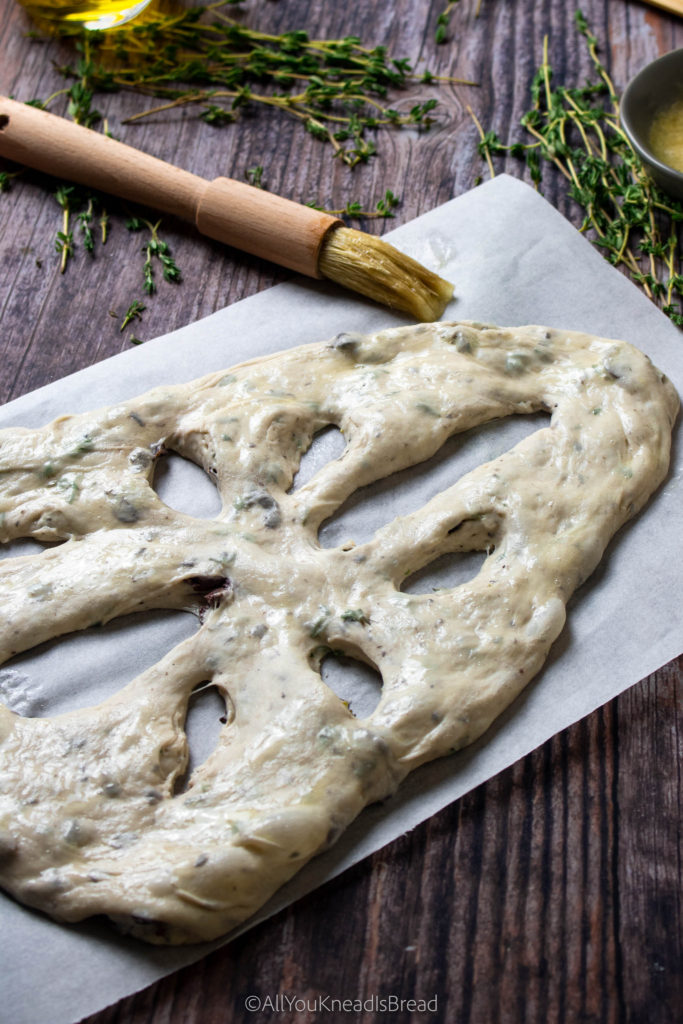Is your sourdough discard jar full and you don’t know what to do with it? Look no further than these soft and moist sourdough discard banana muffins. Packed with flavor, these sourdough banana muffins are a must-try recipe! They are soft, moist, and full of banana flavor. The subtle tang from the sourdough discard adds complexity to every bite. If you have never baked with sourdough discard this is the perfect recipe to start! And I am very confident, that these will be the best sourdough banana muffins you’ll ever make!

Baking Sourdough Discard Banana Muffins
If you’ve never used sourdough discard in baking, it can seem intimidating at first but it’s actually quite simple. Using a 100% hydration starter is usually more convenient because you know that half is water and the other half is flour. With this, you can customize any recipe you want as long as you replace moisture elements (like egg whites, milk, water…) for the corresponding amount of discard.
Another thing to keep in mind is that sourdough discard is acidic, even more so if you use an old one. The acidity can affect the texture of your baked goods, for cakes and cake-like things, the acidity is actually helpful because it can help soften the baked goods.
Why Choose Sourdough Discard for Banana Muffins?
Sourdough discard banana muffins are, in my opinion, the best muffins. And I am always trying to make them better. For me, better means soft and moist with a great flavor and aroma profile.
Baking with sourdough discard not only helps reduce food waste but also adds flavor and texture to your muffins and can increase their shelf life. You can use the leftover sourdough you have after making your weekly loaf, or some old discard that’s been in your fridge for a few weeks. Older, and thus sourer, sourdough discard might produce less sweet muffins because part of the sourness is neutralized by the sugars in the recipe. But the texture will still be great and you can always add more sugar if you want your sourdough discard banana muffins sweeter.
How Sourdough Discard Affects Muffins
The acidity of sourdough discard helps break down the proteins in flour, making the crumb more tender and creating a moist texture in your muffins. It also reacts with leavening agents like baking soda, which gives your muffins a nice lift, making them fluffy and light.
While the tangy flavor of sourdough is very subtle in these muffins, it adds a depth that complements and balances out the sweet bananas. That’s what makes these sourdough discard banana muffins a delicious blend of flavors, creating a balanced and complex taste that sets them apart from traditional banana muffins.
Benefits of using Sourdough Discard in Banana Muffins
Using sourdough discard in baking comes with several benefits. Since sourdough is a fermented product, it can aid in digestion and offer a lower glycemic index compared to traditional baked goods. This makes sourdough discard banana muffins a better alternative to regular banana muffins. Plus, it’s a great way to add more nutrients to your diet, such as B vitamins, thanks to the fermentation process. You can try other recipes like these sourdough blueberry muffins or this sourdough chocolate and orange bundt cake
Ingredients for Moist and Soft Sourdough Discard Banana Muffins
One of the key features of these muffins is how incredibly moist and soft they turn out. This is largely thanks to the unique combination of ingredients. Instead of using milk and butter, this recipe calls for buttermilk, Greek yogurt, and oil. Here is why these ingredients make all the difference:
1. Buttermilk
The acidity of the buttermilk also helps tenderize the muffins by hindering the formation of too-long gluten chains. It also reacts with baking soda, creating tiny air bubbles that will make these sourdough banana muffins fluffier. In essence, the acidity of buttermilk reinforces the effect of the acidity of the sourdough discard.
2. Greek Yogurt
Greek yogurt is thicker than regular yogurt and adds a rich creaminess to the batter. It locks in moisture, keeping these sourdough discard banana muffins tender and moist for longer.
3. Vegetable Oil
The absence of water in oil allows it to coat the flour particles more uniformly and lock in the moisture and preventing these sourdough discard banana muffins from drying out. Oil can also coat the gluten proteins and limit gluten development yielding a much softer texture than butter-based recipes. You can use any oil of your choice that is liquid at room temperature; avocado oil is a good neutral oil, but if you want to give your banana muffins an extra kick you can use olive oil or a mixture.
These ingredients ensure you get the moistest and softest sourdough banana muffins you’ve ever tasted. Whether you’re baking these muffins or other recipes, these ingredients will always help you elevate your muffins.

Role of Overripe Bananas in Sourdough Discard Banana Muffins
When it comes to banana muffins, overripe bananas are a must. The ripening process of bananas brings significant chemical changes that enhance the flavor, sweetness, and texture of your sourdough banana muffins.
Chemical Changes in Overripe Bananas
As bananas ripen, the starches in the fruit break down into sugars. This conversion makes overripe bananas much sweeter and softer compared to green or just-ripe bananas. The sugar content in an overripe banana can be up to 80% higher than in an unripe one, contributing to the overall sweetness of your banana sourdough discard muffins without the need for extra sugar.
Overripe bananas are also softer, which means they integrate more easily into the muffin batter. This creates a smooth, cohesive batter that bakes into a uniformly moist sourdough banana muffin.
What if I don’t have overripe bananas?
If you don’t have overripe bananas you can bake the bananas you have for a few minutes at a low temperature, but personally, I don’t like this method, I prefer to let my bananas ripe naturally. So to ensure that I always have overripe bananas, I just let a bunch go very ripe and then peel and freeze them and collect every overripe banana that nobody would want to eat. I always keep a bag of frozen bananas in my freezer, in our house not a single banana goes to waste!
Frozen bananas can be used for many things such as smoothies, banana bread, oatmeal, or even homemade ice cream! Next time your bananas get too ripe, don’t throw them away. Keep them in the freezer and enjoy them later in these delicious sourdough banana muffins!
How to get tall sourdough discard banana muffins
Achieving tall, bakery-style muffins with a beautiful domed top can be tricky, but it’s all about the technique. Here are my tips for getting your sourdough banana muffins (or any kind of muffin) to rise tall and look professional.

Let the Batter Rest Overnight
Letting your batter rest in the fridge overnight is a game-changer. This rest period allows the flour to fully hydrate and gives the baking soda and baking powder time to activate. It also thickens the batter, which means the muffins will rise more evenly and reach new heights when baked.
Fill the Muffin Cups
To get tall sourdough banana muffins, don’t be afraid to fill your muffin cups almost to the top. Many muffin recipes suggest filling them ⅔ of the way, but for tall muffins, you want the batter to have more volume. Especially if you are not letting the batter rest overnight in the fridge.
Bake at a High Temperature Initially
Start baking your muffins at a high temperature (around 425°F/220°C) for the first 5–10 minutes. The temperature contrast will give the batter a quick burst of heat, helping the muffins rise rapidly. After 10 minutes, reduce the heat to 350°F/180°C to finish baking. This also works with cold batter.
If you’re short on time, feel free to use cold ingredients. The batter will be chilly, but starting with a higher temperature for the first few minutes will help your sourdough discard banana muffins rise taller.
I baked these banana muffins in a jumbo-size pan but you can use any baking pan you have. Just be mindful of the baking time; smaller muffins will bake faster.
These tips will help you achieve tall, bakery-worthy muffins, whether you’re making these sourdough muffins overnight or a fresh batch of blueberry sourdough muffins. So, grab those overripe bananas, pull out your sourdough discard, and get baking!
If you liked this recipe…
You might enjoy these:
Chocolate & orange sourdough discard bundt cake
Sourdough chocolate banana bread
Sourdough Spanish style muffins
If you make any of my recipes let me know what you think! As always you can find me on Instagram, Pinterest, and Facebook. I also have a few videos up on my YouTube channel (which I hope I can resume soon!)
Starting on breadmaking but don’t know where to start? Check my Amazon store to see my favorite and affordable utensils you will need. You can make the best bread with simple and inexpensive tools!
(This post contains affiliate links, if you purchase something from this link I will make a small commission that helps me run this blog, but you will not be charged any extra money 😉 )

The best sourdough banana muffins
Moist, soft, and decadent muffins using your overripe bananas and sourdough discards
Ingredients
- 300 g all purpose flour
- 100 g sourdough discard
- 300 g overripe bananas
- 180 g brown sugar
- 2 eggs large
- 100 ml vegetable oil
- 100 ml buttermilk
- 85 g full fat Greek yogurt
- 5 g vanilla extract
- 10 g baking powder
- 2 g baking soda
- 3 g salt
- 75 g chopped walnuts optional
Instructions
-
Preheat your oven to 425°F (220°C). Line a muffin tin with paper liners.
-
In a medium bowl, whisk together the flour, baking powder, baking soda, and salt.
-
In a separate large bowl, mash the overripe bananas. Add the sourdough discard, brown sugar, eggs, oil, buttermilk, Greek yogurt, and vanilla extract. Mix until smooth.
-
Gently fold the dry ingredients into the wet mixture until just combined. Avoid overmixing.
-
Fold in the chopped walnuts if desired.Fill the muffin cups almost to the top with the batter.
-
Bake at 425°F for 5-10 minutes, then lower the temperature to 350°F (180°C) and bake for another 10-15 minutes, or until a toothpick inserted in the center comes out clean. See notes**
-
Let the muffins cool in the pan for 5 minutes before transferring them to a wire rack to cool completely.
Recipe Notes
** This baking time is for jumbo size muffins. If you are baking smaller muffins, the baking time will be shorter. Always bake until the toothpick comes out clean, even if it means the baking time is different than the recipe’s.
The best Sourdough Fougasse With Pasta Madre discards
Lately, I’ve been focusing on my Pasta Madre a lot. While studying it and playing around with different flours I generated a considerable amount of pasta madre discards. Of course, I found a way to repurpose them instead of throwing them away. I made this fantastic sourdough fougasse with olives and thyme that is going to blow your taste buds! This is the most aromatic sourdough fougasse I’ve ever made! It’s definitely a delicious treat to share and a fantastic appetizer to keep your guests happy while dinner is finishing cooking!
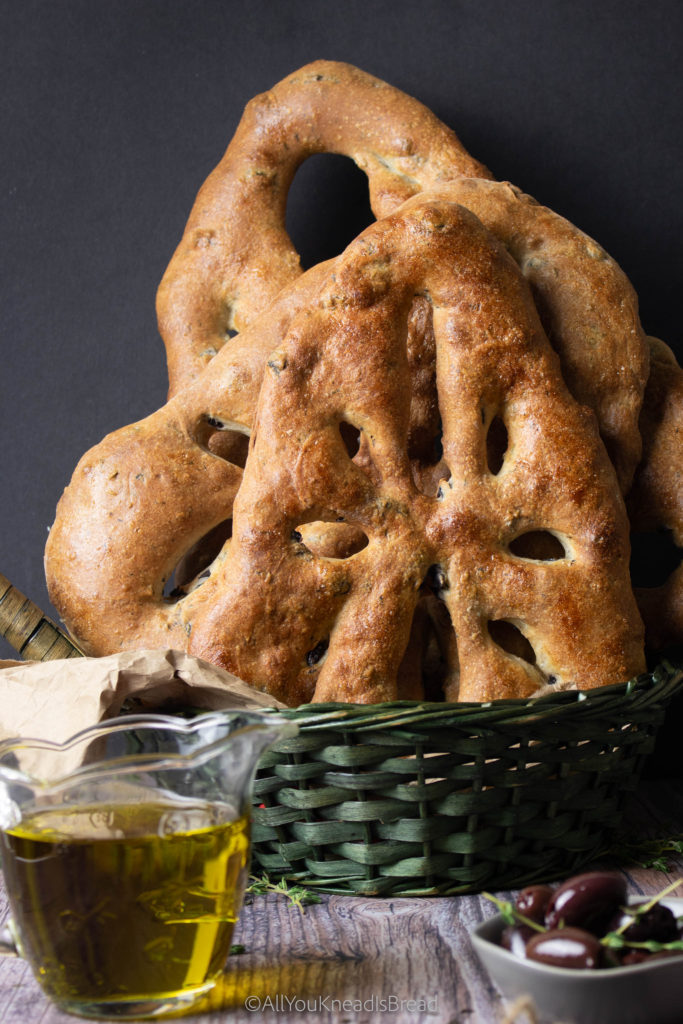
What is fougasse bread?
In a world full of focaccias, baguettes, and sourdough loaves it’s easy for this incredibly delicious bread to go unnoticed. Let me tell you a bit about it!
Fougasse is a French bread typical from Provence although it has more variants in other regions of France. It’s somehow a flatbread and it’s shaped in an irregular shape with slits in the middle. In France is very common to add fillings such as olives, cheese, anchovies…
FUN FACT! this bread was originally used to test the temperature of the wood fire ovens they had back in the day. The bakers could estimate the temperature based on how long it took to bake a fougasse. So there you have it, delicious bread full of tradition!
What is pasta Madre?
In case you’re not familiar with it, let me make a quick summary of what pasta madre is: It’s a special stiff starter used in the making of Grandi Lievitati products, namely Panettone, Pandoro, Colomba… I said special because it’s not *just* a stiff stater. Pasta madre, (or lievito madre, or lievito naturale in some cases) is typically maintained under pretty specific conditions and methods. The method I use is the one where the starter is kept in water. The other method wraps the pasta madre and keeps it tied.
If you want to learn more about it you can check this post to learn how to create your own lievito madre, this post for information about the 3 preparatory refreshments before making panettone, and this post for a mini-guide to troubleshoot your pasta madre.
Stiff starter vs. Pasta Madre, two different things
Social media has done a very poor job of explaining what Pasta Madre is. And frequently people use starters at 60% hydration and call them Pasta Madre. But a real pasta madre s about 35-45% hydration (depends on the flour). And it has a very controlled maintenance process in order to keep a healthy ratio of bacteria and yeasts and promote specific types of LAB. The purpose of this special maintenance is to make a panettone (Grandi lievitati) that is very very very soft, packed with flavor, that can stay fresh for many days and that has not a single hint of acidy nor acidifies over time. Not just to leaven the dough.
Why do I generate so many pasta madre discards?
The thing is… because Pasta Madre is kept either in water or tied up, you can’t really use small amounts of flour because otherwise it’d disintegrate in the water very quickly or it’ll completely dry out in the cloth. My normal maintenance amounts are:150-200g of pasta madre, 150-200g of very strong flour, and 70-80g of water.
Basically, I generate about a pound of pasta madre discards every 24h. And that is a lot of perfectly fine and very strong pasta madre that could be used for other things. I usually keep it in the fridge and accumulate it over a few days and use it to make crackers. I also use it for sourdough loaves, or to make these delicious orange and cinnamon rolls.
And now we have another recipe! This sourdough fougasse is good! Trust me on this! And it uses about all the discard from one refreshment.
If you are using pasta madre discards, I recommend you start the fougasse dough right after the last maintenance refreshment. That is when the pasta madre is at its peak of activity.
Is this a sourdough discard recipe?
Yes, because pasta madre is still sourdough, and a very active one! It’s still a dough packed with wild yeasts and bacteria. And like sourdough discards, you can use it in pretty much anything! It’s also great for stiffer dough, you can use it to make bread like this sourdough challah, or my sourdough burger buns… The options are endless here!
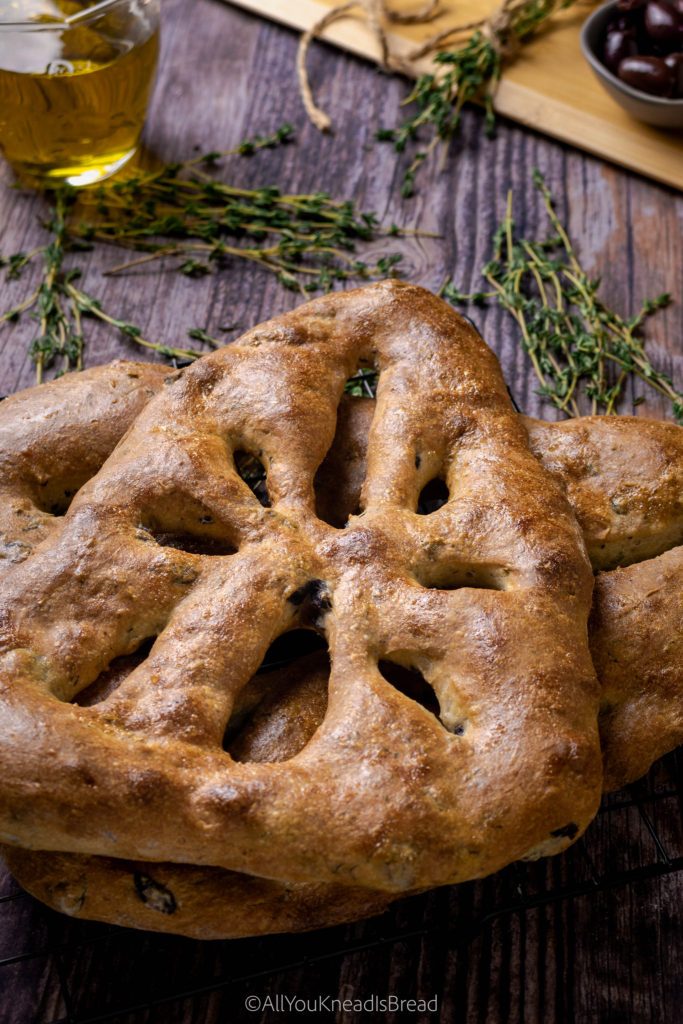
What if I don’t have pasta madre?
Don’t worry! If you don’t have pasta madre you can either create a stiff starter and use it, or use your liquid sourdough starter (100% hydration), I got you!
How to create a stiff starter with your 100% hydration starter
I’m going to show you how to make a shortcut stiff starter at 55% hydration because if we lower the hydration too much, your bacteria will end up a bit stressed and there’s a chance it won’t be active enough to use. You can read all about adaptation periods and water content on this post. It’s about the science of your sourdough starter (without fancy words and easy to follow).
A 55% hydration starter would be very easy to make by mixing 100g of flour with 55g of water. But this will make a total of 155g of starter. We don’t need that much, so we need to scale it down to a total of 100g. So we need to scale down.
| Ingredients | For 155g of starter | For 120g of starter | For 100g of starter |
| Total Flour | 100g | 77.4g | 64.5g |
| Total Water | 55g | 42.6g | 35.5g |
Pay attention to the water
Now, water is our limiting factor here because we just need a little amount. Since we’re using our 100% hydration starter, that means that whatever weight of this starter is made of 50% flour and 50% water.
So, let’s say you want to make 120g of stiff starter (just to play safe). That starter will have 42.6g of water. This water comes ONLY through your liquid starter. Since water is only 50% of the liquid starter, we will need twice the amount. And then to make it stiffer we just add the flour difference. Let me show you!
Twice the amount of 42.6g (of water we need) is 85.2g. We need to take 85.2g of liquid starter (42.6g of water, and 42.6g of flour). And according to the table above, to make 120g of stiff starter we need a total of 77.4g of flour. From our liquid starter, we already have 42.6g of flour. The difference we need to add is: 77.4 – 42.6 = 34.8g
Let me do the math for you!
Too much math for a beautiful day such as this one? Then let me do the numbers and just pick on the table below the amount of starter you prefer to make:
| Ingredient | For a total of 120g of stiff starter | For a total of 100g of stiff starter |
| 100% hydration starter | 85.2g | 71g |
| Extra flour | 34.8g | 29g |
You can now pick how much stiff starter you want and mix the ingredients. Knead the dough by hand for a couple of minutes. You don’t need to develop the gluten perfectly but make sure there aren’t dry flour particles or dry chunks of dough. The idea is to have a dough that is stiff but workable and not sticky. Aim for a bagel dough kind of consistency.
Once mixed put it in a container with a loose lid and wait until at least doubles in size. It’d be helpful to have a narrow and taller container rather than a wider and shorter one. That way it’ll be easier to see how much it grows. Once you see it doubles wait for a while, if it stalls then it’s at the peak, if it continues growing then it’s not at the peak yet. Wait a bit longer and test again.
You also need an active starter to make sure the stiff starter can grow fast and you don’t need to refresh it again to make it stronger. Remember, the purpose of this recipe is to reduce waste 😉
If this is not a method you like, I got you! You can go ahead and use your liquid starter
How to make sourdough fougasse with liquid starter
If you just don’t really care about making a stiff starter or don’t have pasta madre, you can still make this delicious sourdough fougasse with your liquid starter. Just add 100g of the starter and then 21g LESS of water and 21g MORE of flour to the base recipe and you’re good to go! (This is to keep the total dough hydration the same regardless of the starter you’re using).
About this sourdough fougasse recipe
For this fougasse, I chose strong-flavored fillings because pasta madre doesn’t have the sour punch that liquid sourdough has. It’s a milder flavor that I wanted to balance with something savory. Olives and thyme are a combination that I love and along with olive oil and the bread (once is baked) is just perfect.
You can use other ingredients of your preference, although traditionally fougasse has more savory and umami fillings. This can also be an opportunity to let your creativity flow and experiment with how you cut the slits when you’re shaping your bread. Fougasse is truly a gorgeous bread that can just be the perfect centerpiece for a table.

How to prepare this sourdough fougasse
As with any other sourdough bread, we need to start mixing the ingredients. If you know my baking style, you know that I add starter and salt all at the same time. And this case is no different. However, due to the nature of pasta madre, you probably can’t dissolve it in the water the same way you do with a liquid starter.
What I like to do is hold back about 20% of the water to start with a bit of stiffer dough, and then progressively add the rest of the water and finally the wet fillings. This is what works for me, but if you want to add all the water right away and just knead directly it’s fine too.
This is a lovely dough to work with, honestly. You can use your stand mixer but if you want to try doing it by hand, I think it’s a beautiful recipe to do so!
If you’re using a liquid starter just dissolve it in water and proceed with the rest of the ingredients. You don’t need to add water slowly.
When should I add the fillings?
I like to classify fillings into two groups: wet and dry. Wet fillings are those that carry a considerable amount of moisture with them and that could, potentially, alter the dough. These are things like olives, roasted peppers, capers… Dry are those that don’t carry with them much moisture like spices, herbs, cured cheese, dry things preserved in oil (sundried tomatoes, caramelized onion…).
Why this classification? When we need the dough we usually apply pressure to the ingredients that are in the dough. Wet ingredients will release that moisture if we “squeeze” them as we knead the dough. And our somehow stiff dough can become sticky in no time!
What I like to do is add the dry ingredients mixed with the flour and wait until the dough is developed to add the wet, then I just have to knead enough to incorporate the fillings, and not for incorporating them filings and developing the gluten at the same time.
For this sourdough fougasse, I used black olives and thyme. Thyme is not a problem, it’s a “dry” ingredient (even though I used fresh herbs, but you get the idea), you can add it at the beginning with the flour and the other ingredients. Olives, on the other hand, are preserved in brine, they carry quite an amount of moisture. So I added them at the very end. Once the dough was ready and the gluten was where I wanted it to be, I added the olives and kneaded just enough to incorporate them.
Don’t worry if by doing this you still have a couple of olives that aren’t incorporated, just put them on top of the dough, after they bake they’ll give your fougasse a rustic look!
How to ferment this sourdough fougasse
Since fougasse is a flatbread of sorts, it’s okay if the dough is not super strong. In other words, it’s okay if we over ferment it a little if that’s going to fit our schedule better. Here you have a couple of options:
Same day fougasse
Start the dough early in the morning, knead it well, add all the fillings, and let it ferment (bulk ferment) until it doubles in size and gets a bit puffy. Depending on your temperature, this might be anywhere between 3-5h. If you’re using a clear bowl you should see some fermentation bubbles in the bottom but nothing too crazy. Try not to over ferment it or when you want to shape it and cut the slits it’ll be tricky.
Then proceed to divide the dough into as many fougasses as you wish to make, shape them, and let them proof. We’re not looking for super chubby fougasses here. So when you start seeing them rising a bit turn the oven on and continue proofing while the oven preheats.
If you’re an early bird you might have them ready by lunchtime, if you’re a sleepyhead like me, maybe aim for dinner to be safe 🙂 *giggles as she writes this sentence*
Overnight fougasse
This method is based on cutting the bulk and keeping the dough in the fridge until you’re ready to continue. So, let’s say you refresh your pasta madre in the early evening or your stiff starter is not ready until later in the day. Maybe you don’t have time to bake your fougasse the same day. In this case, what you can do is prepare the dough and start the bulk fermentation. Then 1 and a half or two hours later put the bowl in the fridge and keep it there overnight. Then the next morning take the dough out of the fridge and divide it into the number of pieces you want. This way the dough will come to room temperature a bit faster
How to shape your sourdough fougasse
Either if you are following the same-day method or the overnight method. After dividing the pieces shape them into a ball, cover them with a cloth or plastic wrap, and let them rest for 20 minutes or so.
After the rest period is over… Unleash your inner creativity! The basics of shaping a fougasse are:
Flatten the piece of dough into an oval-ish/triangular-ish/leafy-ish shape, then cut slits with a bench scraper or a pizza cutter (bench scraper works better for me), loosen up the slits, and done!
Don’t try to make them perfect, the beauty of a good fougasse is in that rustic touch! I personally like a triangular/leafy kind of shape. I think they look really nice and if you have a bread basket they will look very cute in it. Also, feel free to use plenty of flour to avoid the dough from sticking to the counter. Cutting the slits can be tricky.
Baking your sourdough fougasse
Once you’re done shaping the fougasses, cover them and let them proof at room temperature until they start getting puffy, but didn’t necessarily grow much. At that moment turn your oven on at 425F/220C. The proofing stage will continue as the oven preheats. If you have an old metallic tray, put it in the bottom part oven, you will use it to create steam.
When the oven is ready put your fougasses in the middle part of the oven and throw a cup of boiling water into the bottom tray. This will create a nice touch of steam for the first few minutes.
After 10 minutes or so, you can retrieve the bottom tray and continue baking until your fougasses have a nice golden brown color. Let them cool down on a rack until you can hold them with your hands without burning yourself and enjoy!
A few tips about this sourdough fougasse recipe
For a shiny touch, I like to brush my fougasses with egg wash. This also allows the crust from drying out too quickly. This bread is pretty thin, so a bit of extra moisture is always helpful.
If you don’t want to brush your fougasses with egg wash, you can spray some water before putting them in the oven. This, along with the steam we create with the boiling water, it’ll be enough.
Fougasse is best consumed right away. When it’s crispy outside and soft inside. It’s even better when it’s still warm. This bread is thin, most of the moisture scapes as it bakes, so it goes stale faster than other types of sourdough bread.
Can I use other fillings?
Absolutely! You can use other flavor combinations that you like. I love fresh herbs combined with something extra savory or umami (like olives, blue cheese…). But I also love caramelized onions and nuts together. The sky is the limit here!
Do I really need steam to bake it?
You don’t need it, but I think it’ll be a good idea. I always get better results when I add steam during the first 10 minutes of baking. Since these are pretty thin, the crust will dry out quickly. A bit of steam will help to create a fluffy interior and crispy crust! But if you can’t create steam don’t worry, your fougasse will still turn out delicious!
How big should my fougasse be?
With this recipe, you can make one mega-fougasse, 2 large fougasses, 3 medium fougasses, 4 small ones, or 5 tiny ones. Just be careful when you bake them because the small ones will bake faster.
That is all for today! If you liked this recipe, you might also like these other ones, give them a try and let me know what you think!
Brie and olive sourdough rolls
Tomato and rosemary sourdough bread
Gorgonzola and apple sourdough bread
If you make any of my recipes let me know what you think! As always you can find me on Instagram, Pinterest, and Facebook. And I also have a few videos up on my Youtube channel (which I hope I can resume soon!)
Starting on breadmaking but don’t know where to start? Check my amazon store to see my favorite and affordable utensils you will need. No need to buy a $200+ baking pot. You can make the best bread with simple and affordable tools! (This is an affiliate link if you purchase something from this link I will make a small commission that helps me run this blog, but you will not be charged any extra money 😉 )
Happy Baking!

Sourdough Fougasse with pasta madre discards
Make this incredibly aromatic bread typical from the Provence using your pasta madre discards!
Ingredients
- 500 g bread flour
- 100-120 g pasta madre discards see notes
- 300-350 g water see notes
- 50 g extra virgin olive oil
- 8-10 g salt see notes
- 135 g sliced black olives drained and patted dry
- 10 g fresh thyme leaves chopped
- 1 egg for brushing optional
Instructions
-
Mix salt, chopped thyme, and flour in a bowl and set aside
-
Cut the pasta madre into smaller pieces and add them into the bowl that has the flour mix
-
Add about 80% of the water, the olive oil, and start kneading until you feel the pasta madre is incorporating well into the dough. Then add the rest of the water
-
Knead the dough until the gluten is almost developed and add the drained olives
-
Do a set of stretches & folds to help incorporate the olives. If the dough feels tight and you can't incorporate them, let the dough rest for 20 minutes to relax the gluten. Then proceed again to finish incorporating the olives
-
Once ready lightly oil your bowl and put the dough inside, let it proof at room temperature until it doubles or almost doubles and you see some fermentation bubbles at the bottom (Refer to the post to see how you can do a cold retard of this dough)
-
When the bulk fermentation is over, lightly flour your counter and divide the dough in as many fougasses as you want (3-4 pieces will have a nice medium-small size). Shape the pieces into dough balls, cover them and let them rest 10 minutes
-
Take one dough ball and flatten it with your fingers giving it an oval or semi triangular shape. With your fingertips stretch the dough into a larger piece of about 1cm/0.5in thickness. Use as much flour as needed to avoid the dough from sticking
-
Once you have shaped all pieces cover them and let them rest for 10 minutes
-
Place the pieces on the trays you will use to bake them and with the narrow side of a bench scraper cut slits into the fougasse pieces and stretch them a little so the cuts don't close while the dough proofs and bakes
-
Cover the fougasses and let them proof until you see them getting puffy, then turn on the oven at 425F/220C and finish proofing while the oven preheats. If you want to create some steam place an old metallic tray in the bottom part of the oven
-
When the oven is ready brush the pieces with egg wash for a shinier touch (optional) or just spray some water. Bake them for about 30 minutes or until they get a nice golden brown color. If you are creating steam in the oven you can add a cup of boiling water into the tray that has been preheating in the bottom of the oven.
Recipe Notes
*If you are adding wet fillings (like olives) start with the lesser amount of water, if the fillings are dry (like herbs or cheese), add the greater amount of water
*Use just 8g of salt if you’re using very salty/umami fillings like olives, anchovies… otherwise use 10g
Sourdough Magdalenas
Hello friends! Today I bring one of my mom’s very best recipes: Magdalenas! But I adapted it to sourdough, it’s a great way to use your discards, #zerowaste people! These sourdough magdalenas are super simple to make. And if you have kids around it’s a great activity to do with them. Especially now, that we need to stay indoors as much as possible.
How do I know this? Because magdalenas are the highlight of my childhood! They’re the thing my mom would bake every time we had a potluck at school, or when we were fuzzy at home because we were bored. My sister and I loved filling the cups and licking the spatula at the end. I have great memories of being in the kitchen making magdalenas!
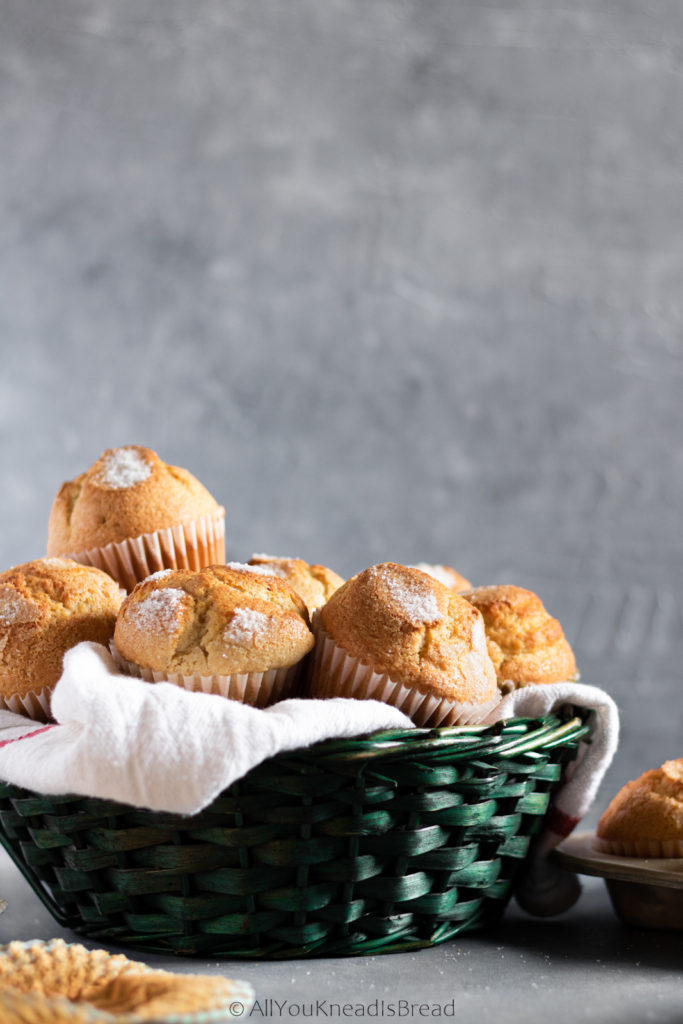
Magdalenas are the Spanish version of a muffin, but airier. They’re very soft and spongy and not too sweet. My mom never used vanilla extract or anything else to enhance the flavor, and I don’t either. I like to taste the olive oil and the eggs. At most, I add orange zest, but I usually keep it simple.
Magdalenas, the perfect snack
In Spain we eat 5 times a day, aside from breakfast, lunch, and dinner, we also cherish our snacks. So much, that they are considered a meal and even have their own name! One is the “almuerzo” which is the morning snack. And the other (my favorite!) is the “merienda“, which is the afternoon snack. Considering we have pretty late dinners (9-10 pm) a good afternoon or early evening snack sounds like a great idea!
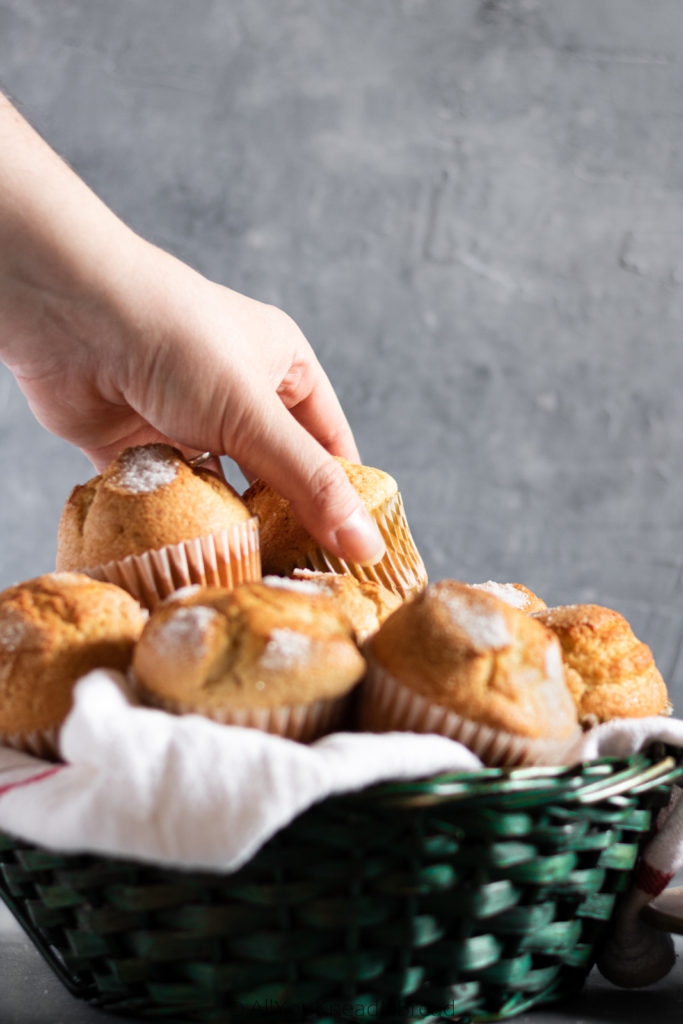
About these sourdough magdalenas
Something that it’s characteristic of magdalenas is their shape. When they grow tall we say they have “copete” and for many people, this is something difficult to achieve. However, I’ve learned that the secret is in letting the batter rest in the fridge before baking. Since the batter is cold, the raising agents (now fully active) can act for a bit longer before the crumb is set, thus giving the madgalenas that final rise.
Letting the batter rest also allows the sourdough ferment. Even though it won’t make the magdalenas sour, some fermentation will increase their nutritional profile and make them easier to digest (The wonders of sourdough, guys!). However, if you don’t have the time, you can bake them right away, the texture won’t change much, you’ll still get delicious magdalenas!
If you’re going to let the dough rest more than 6h, add a little bit more sugar since part of it will be used to neutralize the acids from the sourdough fermentation and won’t contribute to the sweetness of your magdalenas.
The last touch
To get the traditional look of a magdalena, you just need to sprinkle some sugar on top right before baking. It’ll develop a little crust while baking and it’s also a way to decorate the magdalenas.

After baking, let them cool down a little. It’ll help to set the aromas and the structure. And after they cool down you can keep them in an airtight container for a few days.
I did some experiments at home and I tested how the sourdough helped the magdalenas to keep fresh longer. So, I left some outside on the counter overnight (with and without sourdough). The ones with sourdough barely dried out, and overall, they lasted fresh longer than the regular ones.
If you want to know more, check this post where I talk a little about the science behind why sourdough helps in keeping baked goods fresh for longer periods of time.
This recipe yields 18-22 magdalenas (depending on your liners and how much you fill them), but if you want to double or triple it, do so. The recipe is very easy to scale up!
If you don’t have a muffin pan don’t let that stop you! My friends in Bella Cupcake Couture got you covered! Check the post to learn how to bake muffins without a pan or liners!

Let me know if you make these sourdough magdalenas, I’d love to see your creations! You can tag me on instagram or use the hashtag #allyoukneadisbread.
You can find me on Instagram or Facebook and you can also subscribe to my Youtube channel.
Happy baking!
This post contains affiliate links and any sales made through such links will reward me a small commission – at no extra cost for you – that allows me to keep running this blog.

Sourdough Spanish magdalenas
The sourdough version of one of the most typical Spanish muffins
Ingredients
- 300 g cake flour or weak all purpose flour
- 200 g sugar plus more to sprinkle (see notes*)
- 100 g heavy whipping cream
- 100 g olive oil
- 4 eggs see notes**
- 200 g sourdough discards 100% hydration collected throughout a week
- 1 tbsp baking powder
- 1 tbsp orange zest optional
Instructions
-
Whisk the eggs and sugar until fluffy and light in color.
-
Add the starter and break down the blob a little (do it manually if you use your stand mixer, or the starter will curl up the whist attachment)
-
Add the heavy cream and the oil and whisk everything until it's combined.
-
Sift the flour and the baking powder and add the mixture to the wet ingredients in 2 or 3 times to avoid flour flying everywhere.
-
Mix the flour just to incorporate it. If you want to let the batter rest, now it's the time. Cover it with film and keep it in the fridge up to 12h. If you don't want to wait, preheat your oven at 350F.
-
When the oven is ready, line a cupcake pan and fill the cups about 3/4 of the way full, sprinkle with sugar in the center (about 1/2 tsp or so).
-
Bake the magdalenas until they're golden brown and let them rest in the pan for a few minutes.
-
Transfer the magdalenas to a cooling rack and let them cool down to room temperature.
Recipe Notes
* Use a weak all-purpose flour, if it has a high protein content mix it 50/50 with cake flour or your magdalenas will turn out a bit dry.
** You can use eggs straight from the fridge, especially if you are going to let the batter rest for a while in the fridge.
Sourdough Blueberry Muffins
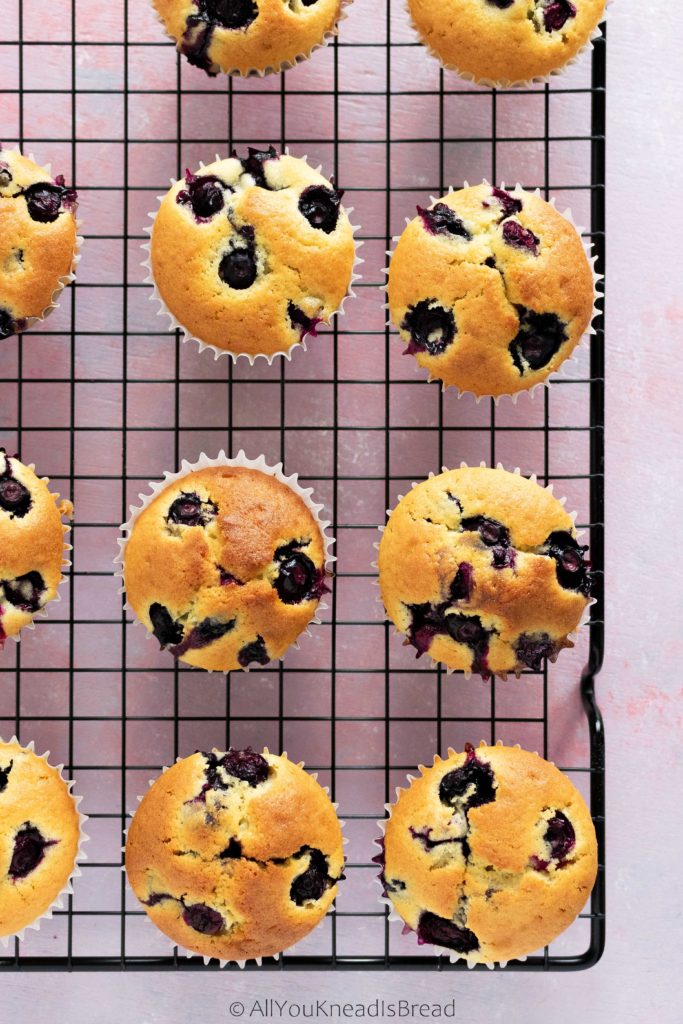
Two words: blueberry muffins. It can’t get better than that. Nah, it can, with sourdough it can! Sourdough blueberry muffins, my friends!
I’m determined to use all my sourdough discards, it is painful to throw it away! So these days the new normal is something like this:
Feed starter – save discards – bake loaf -bake with the discards
The more I bake with sourdough discards, the more I get to test the effect on other food. So far, I can say that cakes and muffins made with sourdough last longer than those without. Nothing new really, sourdough bread also lasts fresh longer time
Isn’t it amazing? Although… after you make these muffins, I doubt you’ll need an extended shelf life, they’re INCREDIBLE!

Why do sourdough baked goods last longer?
Bread and other baked goods are usually discarded when they lose quality rather than when they get spoiled. Bread gets stale kind of quickly, cakes dry and get crumbly… Although there are many factors involved in why and how baked goods dry out, obviously, moisture content plays a key role.
When you mix your ingredients with water, the very first thing that happens is that those ingredients absorb the water. They start making hydrogen bonds and trapping the water within the matrix. Sugar and salt start dissolving, gluten proteins start hydrating, starch granules starch absorbing water and swelling (you see why autolysis helps to develop the gluten? Wink wink)… And all this takes a long time. Much more time than we think.
If we focus on the physical changes of food, rather than the biological changes of sourdough fermentation, we need to pay close attention to how the water is used in baked goods.
Moisture is key
There are two types of water in food: the bound water that’s forming some type of bond and the free water, that is simply stored within the food matrix.
After baking, the free water is going to be the first to go. It moves from the inside of the food (The crumb) towards the outside. Thus, why crust gets soggy over time, and then it finally evaporates and leaves the food.
Bound water, however, it’s somewhat trapped. It can be part of the gluten network, of swollen starch granules, it can be trapped within the fat matrix etc. The amount of bound water (among other things, of course) is one of the things that determines how long the food stays fresh; because its’ much more difficult to separate from the other ingredients. So the loss of quality related to water is slowed down.
Since sourdough baking needs lots of time, the levain preparation, long fermentation times etc. allow all ingredients to keep absorbing water and binding it to other molecules. The flour had many hours to ensure al the particles are saturated with water (I’m assuming a 100% hydration starter here). These bonds survive throughout the whole process; after the food is baked and starts cooling down, the food holds onto these water bonds.
And that’s one of the reasons food made with sourdough lasts longer!
If you’re interested in other food science facts, feel free to send me an email or DM on social media and I’ll try my best to write a post about it!
Back to the muffins!
Alrighty! About these muffins… I made them small for two reasons: 1) because the number of muffins I eat doesn’t depend on the size, so I’d better eat smaller portions now that the gym is close 🙂 and 2) because I don’t have a large muffin tin and if I buy more kitchen stuff my husband is going to make me sleep in the kitchen.
So obviously, feel free to make larger muffins or smaller. Whatever you prefer!
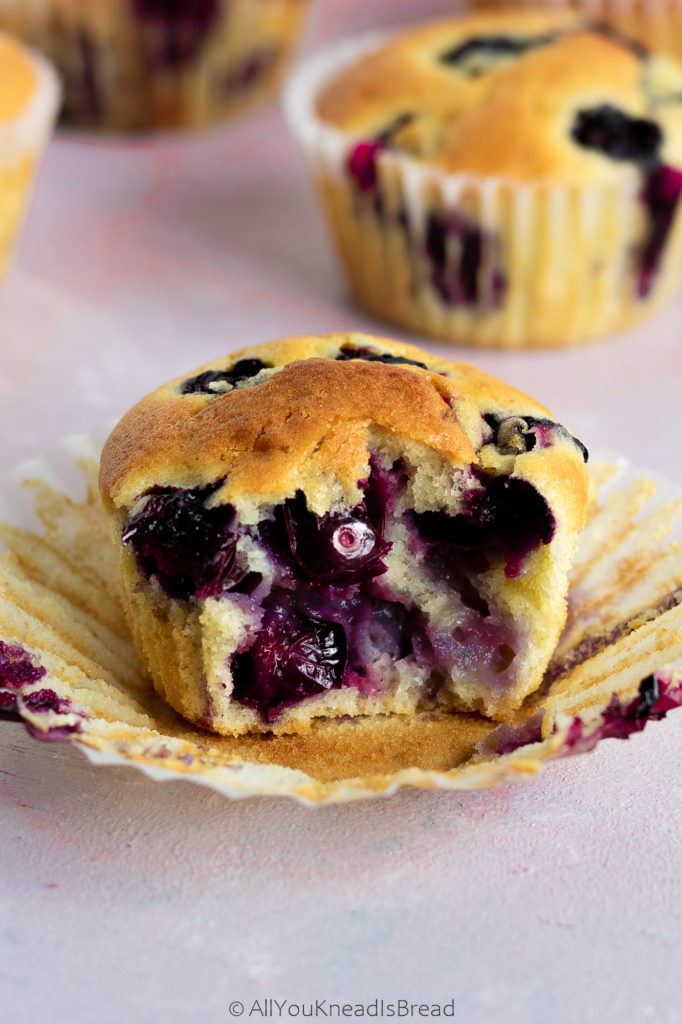
I like to whip eggs and sugar very well, this helps with the airy structure of the muffin and I think the texture turns out super delicate!
Usually, when you make blueberry muffins, they collapse a little after they come out of the oven, it’s normal, that’s because the water inside of the fruits turns into steam while the muffins are baking, and they swell. Some blueberries might burst, and the others, when they cool down, they collapse because the steam condenses. They also wrinkle because the heat affects the structure of the skin.
I like to let the batter chill in the fridge for at least a couple of hours to allow the baking powder and baking soda hydrate well. Their leavening power is activated by acids and moisture. You can leave the batter in the fridge overnight and bake the muffins first thing in the morning!

If you make this recipe, let me know what you think and tag me on your creations! I love to see what you guys do!
You can also follow me on Instagram or Facebook and you can also subscribe to my Youtube channel.
If you have any suggestions or would want me to make some recipes, adapt a yeast-based recipe into a sourdough one, etc, please contact me and I’ll try my best to respond and plan a recipe!
Happy baking!

Sourdough blueberry muffins
Use your sourdough discard to make these delicious muffins!
Ingredients
- 200 g all purpose flour
- 200 g sourdough discards (collected throughout a week)
- 1/2 tsp baking soda
- 1 tsp baking powder
- 1 pinch salt
- 3 L eggs
- 180 g caster sugar
- 1 tsp vanilla extract
- 1 tsp lemon extract (optional- to taste)
- 180 g heavy whipping cream
- 60 g olive oil (see notes)
- 1½ cups blueberries
Instructions
-
Preheat your oven at 375 F
-
Sift the flour into a large bowl. Take a tablespoon of that flour and reserve
-
Add the baking soda, baking powder and salt to the flour and combine
-
In the bowl of your stand mixer whip the eggs until they are fluffy and have a light yellow color
-
Add the sugar to the eggs and combine
-
Add the whipping cream, the oil, the sourdough starter, and the extracts and combine well. Use a spatula if you need to break down the sourdough blob
-
Change from the wire whisk to the paddle attachment, add the flour in 3 batches and combine at medium-low speed
-
In separate bowl toss the blueberries and the tbsp of flour you reserved and carefully stirr tso they blueberries get a nice coat of flour
-
Add the blueberries to the batter and with a spatula stir until just combined (you can put now the batter in the fridge if you want)
-
line a muffin tin with baking cups and fill them to about 3/4
-
Add some blueberries on top as decoration
-
Bake for about 30 minutes or until they have a nice golden color
Recipe Notes
I like to use olive oil because I think it gives muffins in general a really nice aroma. And it’s also how my mom taught me. But feel free to use melted butter or any other oil of your choice!
If you don’t have blueberries, you can make these muffins with any other fruit
Sourdough chocolate and orange bundt cake
Oh, hey there! I’m glad you’re here because I have a wonderful sourdough chocolate orange bundt cake recipe for you! I know… the name it’s kinda long, but trust me, this cake is so delicious, it won’t last long! And I like to think of it as a zero waste recipe. Why? Because I used orange peels and sourdough discards that I collected during the week.
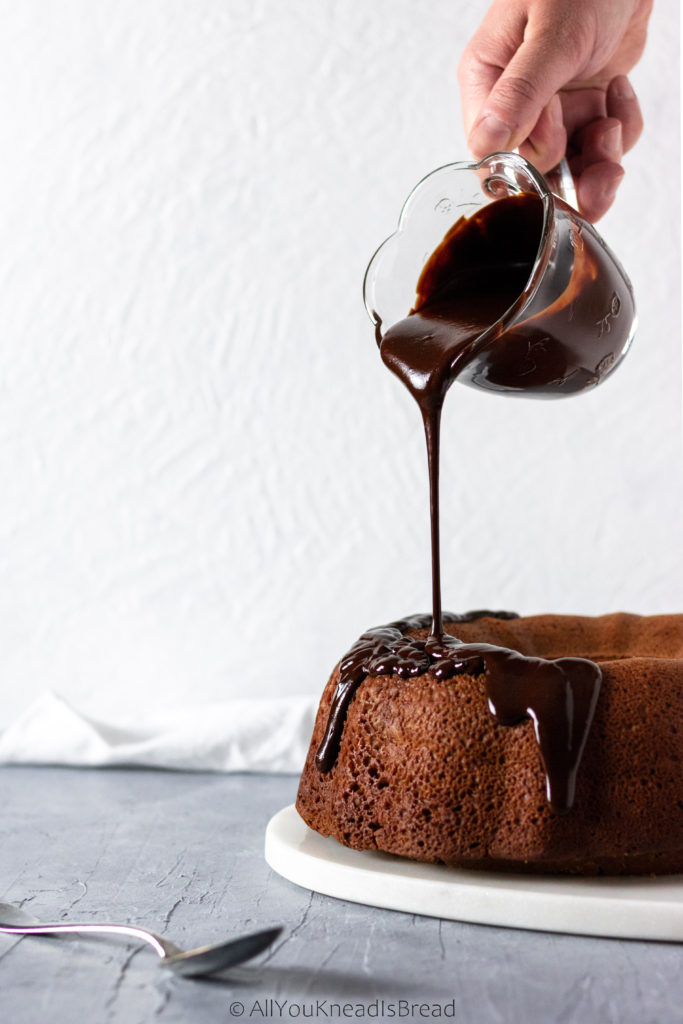
My new challenge in life is to generate less food waste, and that goes to sourdough too. So I’m developing recipes that allow me to do so. The world of sourdough it’s endless! I realized that I can use it in so much more than bread.
I have different sourdough starters that I use for different things. And not long ago I made a chocolate sourdough bread with my chocolate sourdough starter. And that’s pretty much how this cake was born!
If you don’t have a chocolate starter discard, don’t worry, use your regular discards and then substitute 20g of flour with 20g of cocoa powder.
I love the contrast between chocolate and orange and the sourdough starter makes this cake moist and extends its shelf life significantly! It doesn’t taste or get sour; the orange peels are boiled and aren’t bitter and the chocolate flavor is just enough so you can enjoy all flavors.
I made a ganache to add a little something to the cake and topped it with walnuts, but you can use anything you like.

How to prepare the orange peels
The first thing you need to do is to make sure the orange peels are not bitter or they will ruin your cake. You need to put the peels in a sauce pan and add enough water to cover them. Turn the heat to medium-high and cook them until they start boiling. Let them boil for a minute. Drain and rinse them until they’re not too hot. Put them back in the saucepan and repeat 2 or 3 more times (Until you bite a piece and it isn’t bitter).
It’s important to cool down the peels between boils, otherwise, they might disintegrate completely before they are ready.
Once the orange peels are ready, let them cool down and then chop them either manually or with a food processor. They will last in the fridge for a week and you can use them anywhere!
The rest of the steps are similar to any other cake. I used my KitchenAid to mix the batter, but if you don’t have a stand mixer, you can use something else or even do it by hand. Just make sure when you beat the eggs and the sugar, the mixture is foamy. Otherwise, the cake can turn out a bit dense.
Amazing results!

The results are spectacular! This cake is rich, moist and spongy. The flavors come together perfectly, the chocolate flavor complements the tangy orange flavor, and it’s not overly sweet. The sourdough enhances the aromas and really improves the shelf life of the cake. It can stay fresh for several days and I just covered it with foil, I didn’t put it into a plastic container or anything.
Let me know what you think of this recipe and please, tag me on your creations! I love to see what you guys do! You can follow me on Instagram or Facebook and you can also subscribe to my Youtube channel.
If you have any suggestions or would want me to make some recipes, please contact me and I’ll try my best to respond and plan a recipe!
Happy baking!

Sourdough chocolate & orange bundt cake
Use your sourdough dicards and orange peels to make this scrumptious dessert!
Ingredients
Cake
- 340 g all purpose flour *see notes
- 325 g sourdough starter – 100% hydration (about 2 cups)
- 20 g cocoa powder 1
- 300 g white sugar
- 200 g vegetable oil
- 4 L eggs
- 100 g boiled and ground orange peels **see notes
- 70 g milk ***see notes
- 1 tbsp baking powder
- 1/2 tsp salt
- 1 tsp vanilla extract
- 1/2 tsp ground cinnamon optional
Chocolate Glaze
- 3/4 cup semi sweet chocolate chips
- 4 tbsp butter
- 1 pinch ground cinnamon
- 1/4 cup chopped walnuts optional – decoration
Instructions
Cake
-
Preheat your oven at 350F
-
Grease your a bundt cake pan that can hold at least 12 cups
-
On a bowl, mix all dry ingredients and set aside
-
On your stand mixer bowl,add eggs and sugar and beat using the whisk attachment until they're fluffy and the color is lighter
-
Add milk, vegetable oil, orange, and vanilla extract and beat until incorporated
-
Add the sourdough starter and incorporate it at medium speed, you might need to pause or even use a spatula to break it down a little
-
Add the dry ingredients and with a spatula or the paddle attachment incorporate them into the batter. Don't over mix. If possible, don't add all the dry ingredients at once, add them in 2 or 3 times to avoid lumps
-
Bake at 350 for 55-65 minutes or until a toothpick inserted in the middle comes out clean. If needed, tent the cake with aluminum foil to avoind the top from burning
-
When ready, take it out of the oven and let it cool down in the pan for 5-10 minutes, then transfer onto a wire rack
Chocolate glaze
-
When the cake is already baked, melt the butter and the chocolate chips at a very low temperature
-
Add the cinnamon combine it well
-
Pour on top of the cake and decorate with walnuts or any other nut you prefer
Recipe Notes
*I’ve tried both, chocolate sourdough starter and regular sourdough starter. If you have chocolate starter, use it and avoid the cocoa powder and just add 20 more grams of all purpose flour.
**You need to boil the peels 2 or 3 times to get rid of the bitterness. Please, read the paragragh where I explain how to do it 🙂
***If you don’t have enough orange peels, you can use orange juice instead of milk, but 100g or orange peels give this cake a really nice orange flavor.
**** I collected my starter for several days and kept it in the fridge until I baked the cake
How to make sourdough chocolate banana bread

A year ago I was writing that dissertation, I was stressed, hypersensitive, anxious… Sometimes I’d be happy it’d soon be over, and sometimes I’d feel nostalgic for the very same reason. A year has passed and I’m just starting to rebuild myself and enjoy my guilt-free life… With this sourdough chocolate banana bread! That’s right! It’s all about using sourdough discards!
Using sourdough discards in your baking
Learning the science of bread is one of the reasons I started this blog. Because I find breadmaking an incredibly endearing process and yet so misunderstood. There are different methods to take care of your sourdough starter; some people generate discards, others don’t. I never throw away the discards, that’s sourdough that can be used on other things!! It’s pre-fermented flour that can bring flavor to yeast bakes, like this brioche recipe with sourdough discards. It also helps increase the shelf life of baked products by slowing down the staling process and controlling the pH a bit. This way spoilage microorganisms find it harder to grow on the food.
This year I also want to start implementing a new approach when it comes to food: ZERO WASTE. I know many people generate a considerable amount of sourdough discards. And I know using sourdough discards sounds like a crazy idea for many. But let me tell you.. once you make this sourdough chocolate banana bread with sourdough discards, you will be converted forever!!!
So today I inaugurate a new type of recipe: SOURDOUGH DISCARDS
I’ll upload different recipes using sourdough discards so you don’t just throw them away. Recipes with that extra kick of healthiness that only a sourdough starter can provide. As always, all recipes will be tested to ensure the best results!
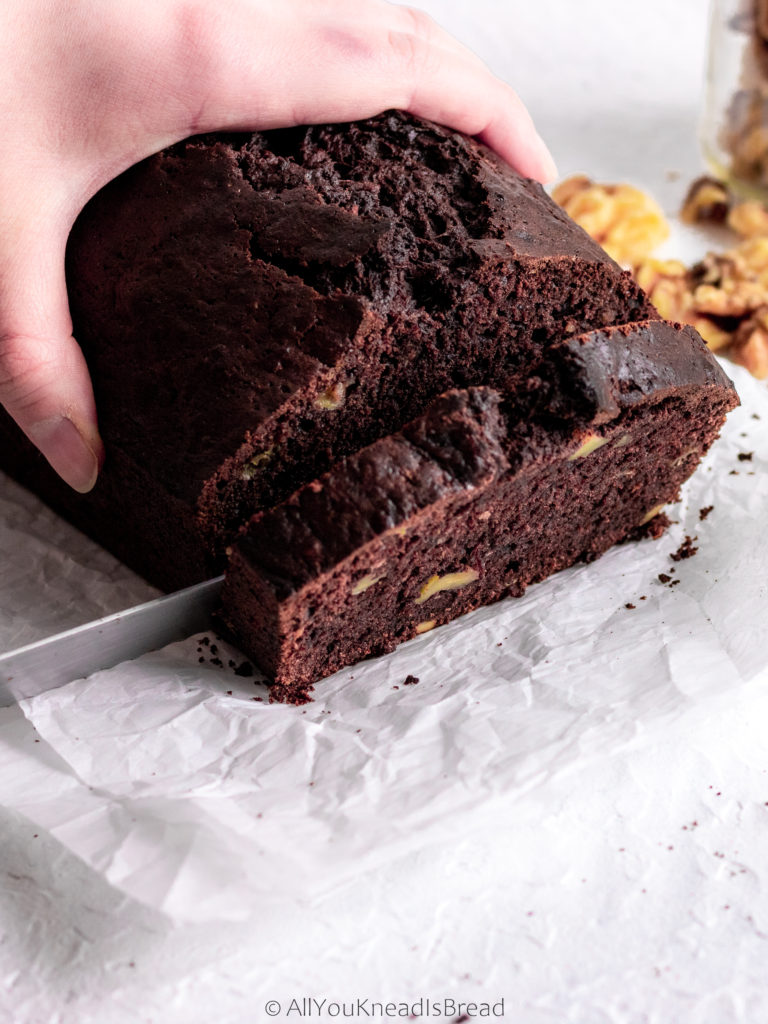
To inaugurate this new batch of recipes I wanted to make something special. I’ve developed this sourdough chocolate banana bread that’s going to make you fall in love with it!
It’s moist but not too dense. It’s spongy, full of flavors, a nice chocolate kick that doesn’t overtake the banana taste. And it lasts fresh for days even if you don’t keep it in an airtight container! (You didn’t think that sourdough could only keep regular bread fresh for a longer time, did you?)
I did not add chocolate chips of any kind to this bread, just walnuts. Because I wanted to taste the banana. But if you prefer a more chocolatey flavor, customize those extras to your taste buds.
About this sourdough chocolate banana bread
It works best with very ripe bananas. Those brown mushy ones? Yeah, those!
If you’re not ready to bake banana bread but your bananas are getting too ripe to eat, just peel them, freeze them and use them whenever you’re ready! Just make sure you drain the water after they thaw. I think frozen bananas are the best for banana bread, they keep the moisture much better and they also enhance the flavor of the bread.
I collected the sourdough discards throughout 3 or 4 days of consecutive feedings and kept it in the fridge until ready to bake.

What if I have old sourdough discards?
I have tested this recipe with discards that were several weeks old. The only difference in flavor is that the chocolate banana bread was less sweet. Which makes sense, because the discards have been acidifying and part of the sugar is used to neutralize those acids.
So, depending on your taste buds, you may want to adapt the sugar. Although, this recipe has a considerable amount of it. But like always, you have the idea here, then you can customize it to your liking! 🙂
How long does it take to bake?
The baking time depends on your oven. Start taking a look at the bread after 50-55 minutes. The best way to know if your banana bread is ready is by inserting a toothpick (or a thin skewer) all the way down in the middle part of the loaf (that’s the part that takes the longest to cook). If it comes out clean, you’re good to go!
Don’t overbake this sourdough chocolate banana bread, you want it moist, not too dry, once the toothpick comes out clean, it’s ready!
Let me know if you make this chocolate banana bread using your sourdough discards and tag me on Instagram or Facebook so I can see your creations! And don’t forget to subscribe to my Youtube channel too, where once in a while I upload videos for some of my recipes.
Enjoy!
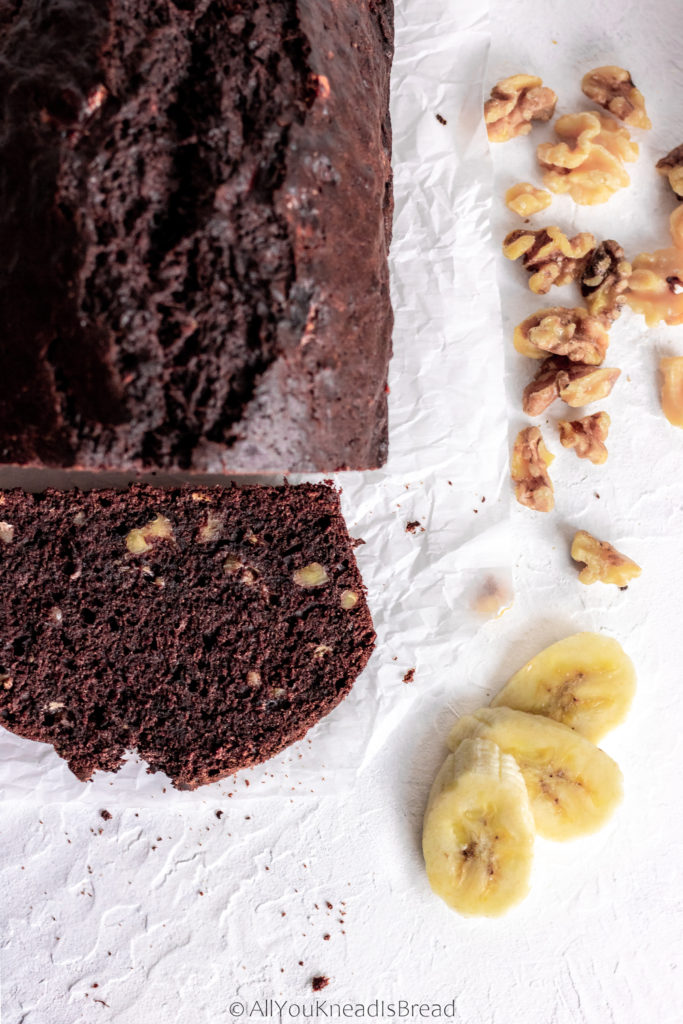
Sourdough chocolate banana bread
Ingredients
- 220 g all-purpose flour
- 40 g unsweetened dark cocoa powder
- 135 g sourdough starter discards
- 180 g brown sugar
- 2 eggs
- 115 g vegetable oil
- 3 very ripe bananas
- 1 tsp baking powder
- 1/4 tsp baking soda
- 1/4 tsp salt
- 1 tsp vanilla extract
- 1 cup chopped walnuts (optional and customizable)
Instructions
- Preheat your oven at 350F
- Grease a 9×5 in mold (or line it with parchment paper if you prefer)
- In a large bowl, combine all dry ingredients (flour, cocoa powder, salt, baking powder, and baking soda) and make sure the baking powder and baking soda don't have any lumps.
- In a smaller bowl whisk the eggs, add the vegetable oil and vanilla extract and combine until the eggs get a light color. Then add the brown sugar and mix for a couple of minutes.
- Add the sourdough starter and stir until it breaks down and it's incorporated (you might see some strands, it's ok, the starter had some gluten developed)
- Mash the bananas, add them to the egg mixture and combine everythng well
- With a spatula, lightly fold the wet ingredients into the dry ones
- Add the chopped walnuts and stir just until they're combined
- pour the batter into your mold and bake for 60 minutes or until a toothpick inserted comes out clean (time might vary depending on your oven temperature)


